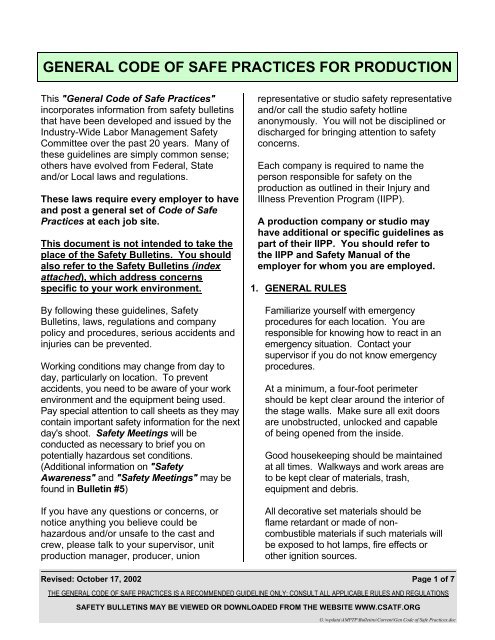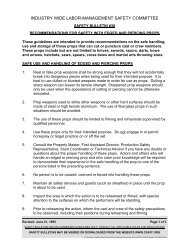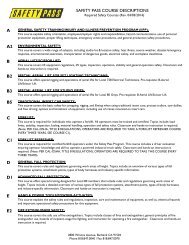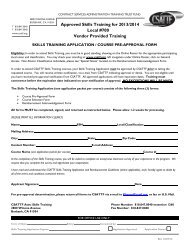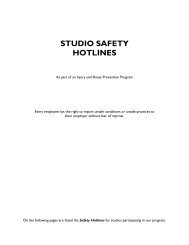General Code of Safe Practices for Production - csatf
General Code of Safe Practices for Production - csatf
General Code of Safe Practices for Production - csatf
Create successful ePaper yourself
Turn your PDF publications into a flip-book with our unique Google optimized e-Paper software.
GENERAL CODE OF SAFE PRACTICES FOR PRODUCTION<br />
This "<strong>General</strong> <strong>Code</strong> <strong>of</strong> <strong>Safe</strong> <strong>Practices</strong>"<br />
incorporates in<strong>for</strong>mation from safety bulletins<br />
that have been developed and issued by the<br />
Industry-Wide Labor Management <strong>Safe</strong>ty<br />
Committee over the past 20 years. Many <strong>of</strong><br />
these guidelines are simply common sense;<br />
others have evolved from Federal, State<br />
and/or Local laws and regulations.<br />
These laws require every employer to have<br />
and post a general set <strong>of</strong> <strong>Code</strong> <strong>of</strong> <strong>Safe</strong><br />
<strong>Practices</strong> at each job site.<br />
This document is not intended to take the<br />
place <strong>of</strong> the <strong>Safe</strong>ty Bulletins. You should<br />
also refer to the <strong>Safe</strong>ty Bulletins (index<br />
attached), which address concerns<br />
specific to your work environment.<br />
By following these guidelines, <strong>Safe</strong>ty<br />
Bulletins, laws, regulations and company<br />
policy and procedures, serious accidents and<br />
injuries can be prevented.<br />
Working conditions may change from day to<br />
day, particularly on location. To prevent<br />
accidents, you need to be aware <strong>of</strong> your work<br />
environment and the equipment being used.<br />
Pay special attention to call sheets as they may<br />
contain important safety in<strong>for</strong>mation <strong>for</strong> the next<br />
day's shoot. <strong>Safe</strong>ty Meetings will be<br />
conducted as necessary to brief you on<br />
potentially hazardous set conditions.<br />
(Additional in<strong>for</strong>mation on "<strong>Safe</strong>ty<br />
Awareness" and "<strong>Safe</strong>ty Meetings" may be<br />
found in Bulletin #5)<br />
If you have any questions or concerns, or<br />
notice anything you believe could be<br />
hazardous and/or unsafe to the cast and<br />
crew, please talk to your supervisor, unit<br />
production manager, producer, union<br />
representative or studio safety representative<br />
and/or call the studio safety hotline<br />
anonymously. You will not be disciplined or<br />
discharged <strong>for</strong> bringing attention to safety<br />
concerns.<br />
Each company is required to name the<br />
person responsible <strong>for</strong> safety on the<br />
production as outlined in their Injury and<br />
Illness Prevention Program (IIPP).<br />
A production company or studio may<br />
have additional or specific guidelines as<br />
part <strong>of</strong> their IIPP. You should refer to<br />
the IIPP and <strong>Safe</strong>ty Manual <strong>of</strong> the<br />
employer <strong>for</strong> whom you are employed.<br />
1. GENERAL RULES<br />
Familiarize yourself with emergency<br />
procedures <strong>for</strong> each location. You are<br />
responsible <strong>for</strong> knowing how to react in an<br />
emergency situation. Contact your<br />
supervisor if you do not know emergency<br />
procedures.<br />
At a minimum, a four-foot perimeter<br />
should be kept clear around the interior <strong>of</strong><br />
the stage walls. Make sure all exit doors<br />
are unobstructed, unlocked and capable<br />
<strong>of</strong> being opened from the inside.<br />
Good housekeeping should be maintained<br />
at all times. Walkways and work areas are<br />
to be kept clear <strong>of</strong> materials, trash,<br />
equipment and debris.<br />
All decorative set materials should be<br />
flame retardant or made <strong>of</strong> noncombustible<br />
materials if such materials will<br />
be exposed to hot lamps, fire effects or<br />
other ignition sources.<br />
Revised: October 17, 2002 Page 1 <strong>of</strong> 7<br />
THE GENERAL CODE OF SAFE PRACTICES IS A RECOMMENDED GUIDELINE ONLY; CONSULT ALL APPLICABLE RULES AND REGULATIONS<br />
SAFETY BULLETINS MAY BE VIEWED OR DOWNLOADED FROM THE WEBSITE WWW.CSATF.ORG<br />
G:\wpdata\AMPTP\Bulletins\Current\Gen <strong>Code</strong> <strong>of</strong> <strong>Safe</strong> <strong>Practices</strong>.doc
<strong>General</strong> <strong>Code</strong> <strong>of</strong> <strong>Safe</strong> <strong>Practices</strong><br />
Obey all "No Smoking" signs. Observe<br />
designated smoking areas and always<br />
extinguish cigarettes in the appropriate<br />
containers (butt cans).<br />
Fire equipment (hydrants, extinguishers,<br />
sprinklers, hoses, etc.) must be accessible at<br />
all times.<br />
Always be aware <strong>of</strong> personnel working above<br />
and below you. All overhead equipment<br />
fixtures and props should be properly<br />
secured.<br />
All cables should be neatly routed. Cables in<br />
walkways and traffic areas should be covered<br />
with mats and/or cable crossovers.<br />
Pranks and other types <strong>of</strong> horseplay are<br />
unacceptable. Distracting crewmembers<br />
could result in accidents and injuries.<br />
Report accidents immediately to your<br />
leadman, <strong>for</strong>eman, supervisor, and/or medical<br />
personnel. Follow instructions given to you<br />
when referred <strong>for</strong> medical treatment <strong>for</strong> any<br />
injury and retain documentation. All injuries<br />
must be reported on the date <strong>of</strong><br />
occurrence.<br />
Wear appropriate clothing and any required<br />
personal protective equipment (PPE). A shirt<br />
and proper footwear should be worn at all<br />
times. <strong>Safe</strong>ty glasses or hearing protection<br />
must be worn when operating equipment or<br />
per<strong>for</strong>ming work where eye or ear damage<br />
could potentially occur.<br />
Medication which might interfere with your<br />
alertness or ability to per<strong>for</strong>m your work<br />
should be used only under a doctor's<br />
direction. If you feel that any medication is<br />
impairing your work, please discuss this<br />
with your supervisor. Do not work while<br />
under the influence <strong>of</strong> illegal drugs or<br />
alcoholic beverages. Don't put yourself or<br />
your fellow workers at risk.<br />
Attend all on-production, <strong>of</strong>f-production<br />
and/or individual department <strong>Safe</strong>ty<br />
Meetings.<br />
If involved in any stunt, special effect,<br />
aviation sequence, water sequence or<br />
other potentially hazardous or unusual<br />
activities, attend any additional <strong>Safe</strong>ty<br />
Meetings held <strong>for</strong> that activity.<br />
Be aware <strong>of</strong> general location safety<br />
concerns, including extreme temperature<br />
conditions, physical surroundings,<br />
indigenous critters and nasty plants.<br />
Additional in<strong>for</strong>mation can be found in<br />
Industry <strong>Safe</strong>ty Bulletins #17, #21, #26,<br />
#27, #31, #34, #34A and #35.<br />
2. LIFTING AND MOVING OBJECTS<br />
Lifting loads improperly can cause<br />
back injuries.<br />
Make sure you get the appropriate<br />
assistance when lifting or moving heavy<br />
or awkward objects. Avoid lifting such<br />
objects whenever possible by using carts,<br />
dollies and other mechanical devices or<br />
GET ADEQUATE HELP.<br />
Be<strong>for</strong>e lifting any load, check <strong>for</strong> slivers,<br />
jagged edges, burrs, rough or slippery<br />
surfaces and protruding nails.<br />
Check your intended path <strong>for</strong><br />
obstructions.<br />
Revised: October 17, 2002 Page 2 <strong>of</strong> 7<br />
THIS CODE OF SAFE PRACTICES IS A RECOMMENDED GUIDELINE ONLY; CONSULT ALL APPLICABLE RULES AND REGULATIONS<br />
SAFETY BULLETINS MAY BE VIEWED OR DOWNLOADED FROM THE WEBSITE WWW.CSATF.ORG<br />
G:\wpdata\AMPTP\Bulletins\Current\Gen <strong>Code</strong> <strong>of</strong> <strong>Safe</strong> <strong>Practices</strong>.doc
<strong>General</strong> <strong>Code</strong> <strong>of</strong> <strong>Safe</strong> <strong>Practices</strong><br />
3. COMMON FALL RISKS<br />
Fall Protection:<br />
Use appropriate fall protection equipment<br />
whenever you are working greater than 30<br />
inches (general use/Cali<strong>for</strong>nia) or 6 feet<br />
(during construction) above the floor,<br />
ground or other working area, when<br />
standard guardrails or other equivalent<br />
protection is not available.<br />
Unprotected work areas such as plat<strong>for</strong>ms,<br />
sets, walkways, cliffs, floor openings,<br />
shafts and ro<strong>of</strong>tops (when approaching<br />
within 6 feet <strong>of</strong> the ro<strong>of</strong>'s edge) require the<br />
use <strong>of</strong> approved fall protection measures.<br />
These measures include but are not<br />
limited to guardrails, barriers, safety net<br />
systems, a written fall protection plan,<br />
and/or the use <strong>of</strong> personal fall arrest, fall<br />
restraint, or work positioning systems.<br />
Fall arrest equipment is always required<br />
when working in the permanent grid and<br />
truss system (perms) outside the catwalks<br />
and handrails.<br />
DO NOT use fall protection equipment<br />
without proper training and instruction. Only<br />
use appropriate anchorage points.<br />
Temporary stair railings and guardrails are<br />
required around elevated surfaces, pits,<br />
holes or other unprotected openings.<br />
Ensure proper lighting in such areas and<br />
post signs as necessary.<br />
Scaffolds:<br />
removed to per<strong>for</strong>m special work. REPORT<br />
any missing guardrails at once.<br />
DO NOT climb across braces.<br />
Ladders:<br />
Inspect all ladders be<strong>for</strong>e each use <strong>for</strong><br />
broken or missing rungs, steps, split side<br />
rails or other defects.<br />
NEVER place ladders in doorways<br />
unless protected by barricades or<br />
guards.<br />
NEVER stand on the top two rungs <strong>of</strong> a<br />
ladder.<br />
USE only approved ladders or steps.<br />
Check the labels <strong>for</strong> compliance.<br />
ALWAYS USE both hands while<br />
climbing.<br />
4. CHEMICALS AND FLAMMABLE<br />
MATERIALS<br />
Store all flammable liquids in approved<br />
safety containers or cabinets. Paint,<br />
chemicals, and other materials should<br />
not accumulate on stage floors, under<br />
plat<strong>for</strong>ms or in other work areas.<br />
You should know and follow proper<br />
handling and storage procedures <strong>for</strong> all<br />
combustible or flammable materials.<br />
Ensure that there is proper ventilation<br />
and wear appropriate personal protective<br />
equipment (PPE).<br />
Only use scaffolds with the appropriate<br />
guardrails, mid rails and toe boards. DO<br />
NOT remove guardrails; contact the scaffold<br />
"competent person" if they need to be<br />
A Material <strong>Safe</strong>ty Data Sheet (MSDS)<br />
shall be obtained from the manufacturer<br />
or distributor and a copy <strong>of</strong> the MSDS<br />
must be kept on file <strong>for</strong> all chemicals and<br />
substances being used and/or stored.<br />
Revised: October 17, 2002 Page 3 <strong>of</strong> 7<br />
THIS CODE OF SAFE PRACTICES IS A RECOMMENDED GUIDELINE ONLY; CONSULT ALL APPLICABLE RULES AND REGULATIONS<br />
SAFETY BULLETINS MAY BE VIEWED OR DOWNLOADED FROM THE WEBSITE WWW.CSATF.ORG<br />
G:\wpdata\AMPTP\Bulletins\Current\Gen <strong>Code</strong> <strong>of</strong> <strong>Safe</strong> <strong>Practices</strong>.doc
<strong>General</strong> <strong>Code</strong> <strong>of</strong> <strong>Safe</strong> <strong>Practices</strong><br />
5. HAND TOOLS AND RELATED<br />
EQUIPMENT<br />
Use the right tool <strong>for</strong> the job. Do Not use<br />
tools or equipment <strong>for</strong> which you have not<br />
been properly trained and qualified. See<br />
your supervisor if you are unfamiliar with the<br />
equipment, have any questions or feel that<br />
you need additional training.<br />
Ensure that all equipment is in proper<br />
working order and that all protective<br />
guards are in place and used.<br />
Do Not attempt to alter, modify, displace, or<br />
remove any existing safety equipment. Saw<br />
guards, safety switches and other safety<br />
mechanisms are installed <strong>for</strong> your<br />
protection. Tag ("Do Not Use") and report<br />
any damaged or malfunctioning equipment.<br />
Wear appropriate personal protective<br />
equipment (PPE) and be aware <strong>of</strong> flying<br />
debris.<br />
Additional in<strong>for</strong>mation can be found in<br />
Industry <strong>Safe</strong>ty Bulletin #21.<br />
Use the proper equipment <strong>for</strong> the job; be<br />
aware <strong>of</strong> load and rider capacities. Never<br />
allow more than 9 people (including the<br />
driver) on an insert car.<br />
Operators and passengers <strong>of</strong> all vehicles<br />
should always use personal protective<br />
equipment (PPE).<br />
Obtain training from a qualified instructor prior<br />
to operating aerial lift plat<strong>for</strong>ms, scissor lifts,<br />
<strong>for</strong>klifts or rough terrain variable-reach <strong>for</strong>klifts.<br />
OSHA requires the operators <strong>of</strong> such<br />
equipment to wear approved personal<br />
protective equipment (PPE).<br />
Be particularly cautious when driving,<br />
walking or traveling; proceed slowly and<br />
watch <strong>for</strong> sudden movements <strong>of</strong> objects or<br />
individuals.<br />
Be especially careful when working around<br />
helicopters or on runways. Remain at least 50<br />
feet away from helicopters or other aircraft<br />
unless directed by the Aerial Coordinator<br />
and/or Pilot in Command or ground safety<br />
contact.<br />
6. FILMING EQUIPMENT & VEHICLES<br />
(Including Booms, Camera & Insert Cars,<br />
Cranes, Process Trailers, Tow Dollies,<br />
Camera Dollies, Elevated Plat<strong>for</strong>ms, Fixed<br />
Wing Aircraft, Boats, Cars, Helicopters,<br />
Motorcycles, Trains)<br />
Ratchet straps and/or ropes are the<br />
preferred method <strong>of</strong> securing loads<br />
and/or equipment. If using “bungees,”<br />
“rubber snubbers” or other elastic-type<br />
devices, ensure they are not frayed,<br />
worn, damaged, cracked or have<br />
damaged or bent hooking devices.<br />
Uncontrolled release can cause severe<br />
injuries to unprotected body parts,<br />
particularly to the face or eyes.<br />
Under no circumstances should you<br />
approach the helicopter or aircraft without<br />
permission from the ground safety contact<br />
or the Pilot in Command.<br />
Whether the rotors are turning or not, always<br />
approach and leave the helicopter from the<br />
front. NEVER WALK NEAR OR AROUND<br />
THE TAIL ROTOR OF A HELICOPTER.<br />
The use <strong>of</strong> aircraft, boats, trains or cars may<br />
require special permits and/or operator<br />
certifications. All vehicles, including their<br />
peripheral safety equipment (i.e., harnesses,<br />
belts, roll-cage, fuel cells, etc.), must undergo<br />
thorough safety inspection and testing on a<br />
daily basis by qualified experienced personnel.<br />
Revised: October 17, 2002 Page 4 <strong>of</strong> 7<br />
THIS CODE OF SAFE PRACTICES IS A RECOMMENDED GUIDELINE ONLY; CONSULT ALL APPLICABLE RULES AND REGULATIONS<br />
SAFETY BULLETINS MAY BE VIEWED OR DOWNLOADED FROM THE WEBSITE WWW.CSATF.ORG<br />
G:\wpdata\AMPTP\Bulletins\Current\Gen <strong>Code</strong> <strong>of</strong> <strong>Safe</strong> <strong>Practices</strong>.doc
<strong>General</strong> <strong>Code</strong> <strong>of</strong> <strong>Safe</strong> <strong>Practices</strong><br />
Additional in<strong>for</strong>mation can be found in<br />
Industry <strong>Safe</strong>ty Bulletins #3, #3A, #8,<br />
#8A, #8B, #8C, #11, #11A, #15, #20, #22,<br />
#28, #29, #29A, #36 and #37.<br />
7. ELECTRICAL SAFETY<br />
POWER LINES: Cali<strong>for</strong>nia <strong>Code</strong> <strong>of</strong><br />
Regulation, Title 8, Section 2946,<br />
Overhead Clearances, must be observed<br />
and maintained at all times (applicable<br />
regulations are set <strong>for</strong>th in Addendum #8C,<br />
#22A and #25A <strong>of</strong> the Industry <strong>Safe</strong>ty<br />
Bulletins). This applies to ladders,<br />
scaffolds, booms, <strong>for</strong>klifts, aerial lifts, scissor<br />
lifts, cranes, rigging, sets, truss work,<br />
backdrops and other equipment that could<br />
come in contact with power lines.<br />
To prevent electrocutions and injury<br />
resulting from contact between overhead<br />
power lines and conductive tools, materials,<br />
or scaffolds, OSHA recommends that<br />
employees be in<strong>for</strong>med that most overhead,<br />
high voltage power lines are not insulated<br />
and, when in doubt, employees should<br />
assume that power lines are not insulated.<br />
Employers should notify the utility company<br />
when work must be per<strong>for</strong>med under and/or<br />
near overhead power lines where<br />
clearances cannot be maintained. In such<br />
situations, utility companies should deenergize<br />
the power lines or temporarily<br />
move or cover them with insulating hoses or<br />
blankets be<strong>for</strong>e any work is initiated.<br />
Properly maintain all electrical equipment<br />
and wiring; no live parts should be exposed.<br />
Use equipment only <strong>for</strong> its intended<br />
purpose. Be particularly careful around<br />
water, especially when filming in rain<br />
scenes.<br />
Keep electric panels accessible at all<br />
times. There should be no obstructions or<br />
storage within three feet (3’) <strong>of</strong> a panel.<br />
Remember that lights placed too closely to<br />
props, sets and other materials may pose<br />
a fire risk and, there<strong>for</strong>e, make sure that<br />
lights are placed far enough away to<br />
alleviate risk.<br />
Only qualified persons with the appropriate<br />
technical knowledge should per<strong>for</strong>m<br />
electrical work.<br />
Additional in<strong>for</strong>mation can be found in<br />
Industry <strong>Safe</strong>ty Bulletins #8, #8A, #22,<br />
#22A, #23, #23A and 25.<br />
8. WATER HAZARDS<br />
If working on or near water, an<br />
employee should make the <strong>Production</strong><br />
Company aware if he or she has a fear<br />
<strong>of</strong> working around water or cannot<br />
swim.<br />
All cast and crewmembers working on or<br />
near water should wear life vests or other<br />
water safety gear when appropriate.<br />
When using watercraft, be aware <strong>of</strong> load<br />
and rider capacity limits. Only required<br />
personnel should be on watercraft; all<br />
others should remain on land.<br />
<strong>Safe</strong>ty lines, nets, watch safety personnel<br />
and/or divers should be used when filming<br />
in rivers or other bodies <strong>of</strong> water where<br />
potentially hazardous conditions could<br />
exist (e.g., swift currents, thick underwater<br />
plant life, or rocks).<br />
All A.C. (alternating current) electrical<br />
systems shall be grounded.<br />
Revised: October 17, 2002 Page 5 <strong>of</strong> 7<br />
THIS CODE OF SAFE PRACTICES IS A RECOMMENDED GUIDELINE ONLY; CONSULT ALL APPLICABLE RULES AND REGULATIONS<br />
SAFETY BULLETINS MAY BE VIEWED OR DOWNLOADED FROM THE WEBSITE WWW.CSATF.ORG<br />
G:\wpdata\AMPTP\Bulletins\Current\Gen <strong>Code</strong> <strong>of</strong> <strong>Safe</strong> <strong>Practices</strong>.doc
<strong>General</strong> <strong>Code</strong> <strong>of</strong> <strong>Safe</strong> <strong>Practices</strong><br />
Know as much as you can about the<br />
body <strong>of</strong> water you’re working on or in,<br />
including its natural hazards and animal<br />
life. The <strong>Production</strong> Company, Location<br />
Manager or the <strong>Safe</strong>ty Coordinator<br />
should have all relevant in<strong>for</strong>mation.<br />
If personnel are going to enter the water,<br />
when appropriate, samples <strong>of</strong> the water<br />
should be taken and analyzed <strong>for</strong> any<br />
potential environmental concerns and/or<br />
health hazards.<br />
Additional in<strong>for</strong>mation can be found<br />
in Industry <strong>Safe</strong>ty Bulletins #7, #15<br />
and #17.<br />
by the special effects and/or stunt<br />
coordinator shall be allowed in the area.<br />
Radios, cell phones, pagers, personal<br />
data assistants (PDAs), transmitting<br />
equipment or remote control equipment<br />
should not be used around pyrotechnic<br />
or other explosive devices.<br />
Additional in<strong>for</strong>mation can be found<br />
in Industry <strong>Safe</strong>ty Bulletins #1, #2,<br />
#3A, #4, #11A, #14, #16, #18, #20,<br />
#29A, #30 and #37.<br />
10. ARTIFICIALLY CREATED SMOKES,<br />
FOGS & DUST EFFECTS<br />
9. STUNTS & SPECIAL EFFECTS<br />
All stunts and special effects should be<br />
reviewed by all participants prior to<br />
execution to help ensure that they are<br />
per<strong>for</strong>med in the safest manner possible.<br />
Be<strong>for</strong>e filming a stunt or special effect,<br />
the involved parties should all per<strong>for</strong>m an<br />
on-site dry run or walk-through. A safety<br />
meeting should be held and<br />
documented.<br />
Special effects involving pyrotechnics,<br />
explosives and/or fire must be noted in<br />
advance on the call sheet. Properly<br />
licensed individuals must per<strong>for</strong>m all<br />
such effects. The necessary permits<br />
must be obtained and the appropriate<br />
regulatory agencies notified. Explosives<br />
must be stored and disposed <strong>of</strong> properly.<br />
Appropriate personal protection<br />
equipment (PPE) and/or other safety<br />
equipment must be provided to the cast<br />
and crew as needed. There must be a<br />
planned escape route and each person<br />
involved should personally check all<br />
escape routes. Only persons authorized<br />
Be aware that the use <strong>of</strong> atmosphere<br />
smoke has become highly regulated and<br />
limited by a variety <strong>of</strong> regulatory<br />
agencies. Contact the <strong>Safe</strong>ty<br />
Coordinator or Studio <strong>Safe</strong>ty<br />
Representative <strong>for</strong> guidelines and<br />
regulations.<br />
Additional in<strong>for</strong>mation can be found<br />
in Industry <strong>Safe</strong>ty Bulletin #10 and the<br />
Photographic Dust Awareness Sheet.<br />
11. FIREARMS & OTHER WEAPONS<br />
Treat all weapons as though they are<br />
loaded and/or ready to use. Do not play<br />
with weapons and never point one at<br />
anyone, including yourself. Follow the<br />
directions <strong>of</strong> the Property Master and/or<br />
Weapons Handler regarding all weapons.<br />
The use <strong>of</strong> firearms and other weapons<br />
may require special permits and/or operator<br />
certifications. Anyone that will be using a<br />
weapon shall know all the operating<br />
features and safety devices. All weapons<br />
must undergo thorough safety inspection,<br />
testing and cleaning on a daily basis by<br />
qualified personnel.<br />
Revised: October 17, 2002 Page 6 <strong>of</strong> 7<br />
THIS CODE OF SAFE PRACTICES IS A RECOMMENDED GUIDELINE ONLY; CONSULT ALL APPLICABLE RULES AND REGULATIONS<br />
SAFETY BULLETINS MAY BE VIEWED OR DOWNLOADED FROM THE WEBSITE WWW.CSATF.ORG<br />
G:\wpdata\AMPTP\Bulletins\Current\Gen <strong>Code</strong> <strong>of</strong> <strong>Safe</strong> <strong>Practices</strong>.doc
<strong>General</strong> <strong>Code</strong> <strong>of</strong> <strong>Safe</strong> <strong>Practices</strong><br />
Anyone handling a weapon shall receive<br />
the proper training and know all operating<br />
features and safety devices.<br />
If firearms and other weapons are used in<br />
filming, the Property Master and/or<br />
Weapons Handler must meet with cast<br />
and crew and in<strong>for</strong>m them <strong>of</strong> the safety<br />
precautions in effect and answer any<br />
questions.<br />
Additional in<strong>for</strong>mation can be found in<br />
Industry <strong>Safe</strong>ty Bulletins #1, #2, #16<br />
and #30.<br />
12. ANIMALS<br />
Animals are unpredictable. If animals are<br />
used in filming, the Animal Handler should<br />
meet with cast and crew and in<strong>for</strong>m them<br />
<strong>of</strong> the safety procedures in effect and<br />
answer any questions. <strong>Safe</strong>ty meetings<br />
should be held when appropriate.<br />
Do not feed, pet or play with any animal<br />
without the permission and direct<br />
supervision <strong>of</strong> its trainer. Defer to the<br />
animal trainers at all times.<br />
When working with exotic animals, the set<br />
should be closed and notices posted to<br />
that effect, including a note on the call<br />
sheet.<br />
Additional in<strong>for</strong>mation can be found<br />
in Industry <strong>Safe</strong>ty Bulletins #6, #12<br />
and #31.<br />
13. ENVIRONMENTAL CONCERNS<br />
All hazardous waste generated by the<br />
company, including paint, must be<br />
disposed <strong>of</strong> properly. Proper<br />
documentation and permits <strong>for</strong> the<br />
transportation and disposal <strong>of</strong> such waste is<br />
required by law.<br />
Be aware <strong>of</strong> hazards associated with lead<br />
paint and asbestos. If encountered, do not<br />
disturb and immediately report to your<br />
supervisor or safety representative.<br />
Be aware <strong>of</strong> biological hazards such as<br />
human or animal waste, mold, fungus,<br />
bacteria, body fluids, blood borne pathogens,<br />
used needles (sharps), vermin, insects and<br />
other potentially infectious materials.<br />
Employees shall not enter confined spaces<br />
(manholes, underground vaults, chambers,<br />
silos, etc.) until the oxygen and gas levels<br />
have been checked and confirmed to be<br />
within acceptable levels.<br />
Certain situations may require permits<br />
and/or licenses, <strong>for</strong> example, when the<br />
production will be using artificial smoke,<br />
large dust effects, creating excessive noise<br />
or when working around endangered plant<br />
or animal life. Please be sure to comply with<br />
all applicable statutes and/or regulations.<br />
Additional in<strong>for</strong>mation can be found in<br />
Industry <strong>Safe</strong>ty Bulletins #17, #24 and<br />
#26.<br />
NOTE:<br />
Additional in<strong>for</strong>mation regarding "job<br />
specific" safe practices and guidelines<br />
relating to special equipment should be<br />
reviewed as necessary. Contact the<br />
production company <strong>Safe</strong>ty Coordinator,<br />
Studio <strong>Safe</strong>ty Representative, supervisor<br />
or your union representative <strong>for</strong><br />
additional in<strong>for</strong>mation.<br />
Revised: October 17, 2002 Page 7 <strong>of</strong> 7<br />
THIS CODE OF SAFE PRACTICES IS A RECOMMENDED GUIDELINE ONLY; CONSULT ALL APPLICABLE RULES AND REGULATIONS<br />
SAFETY BULLETINS MAY BE VIEWED OR DOWNLOADED FROM THE WEBSITE WWW.CSATF.ORG<br />
G:\wpdata\AMPTP\Bulletins\Current\Gen <strong>Code</strong> <strong>of</strong> <strong>Safe</strong> <strong>Practices</strong>.doc


